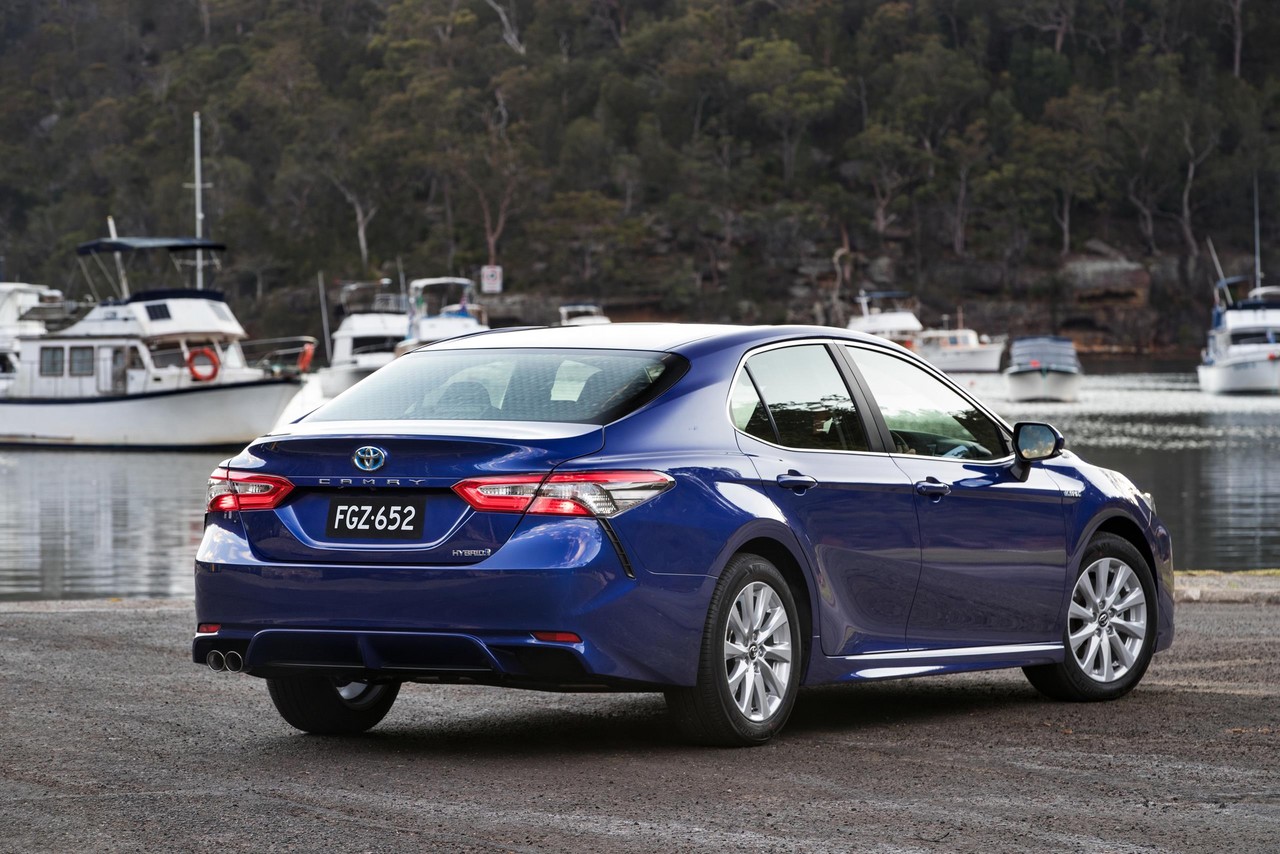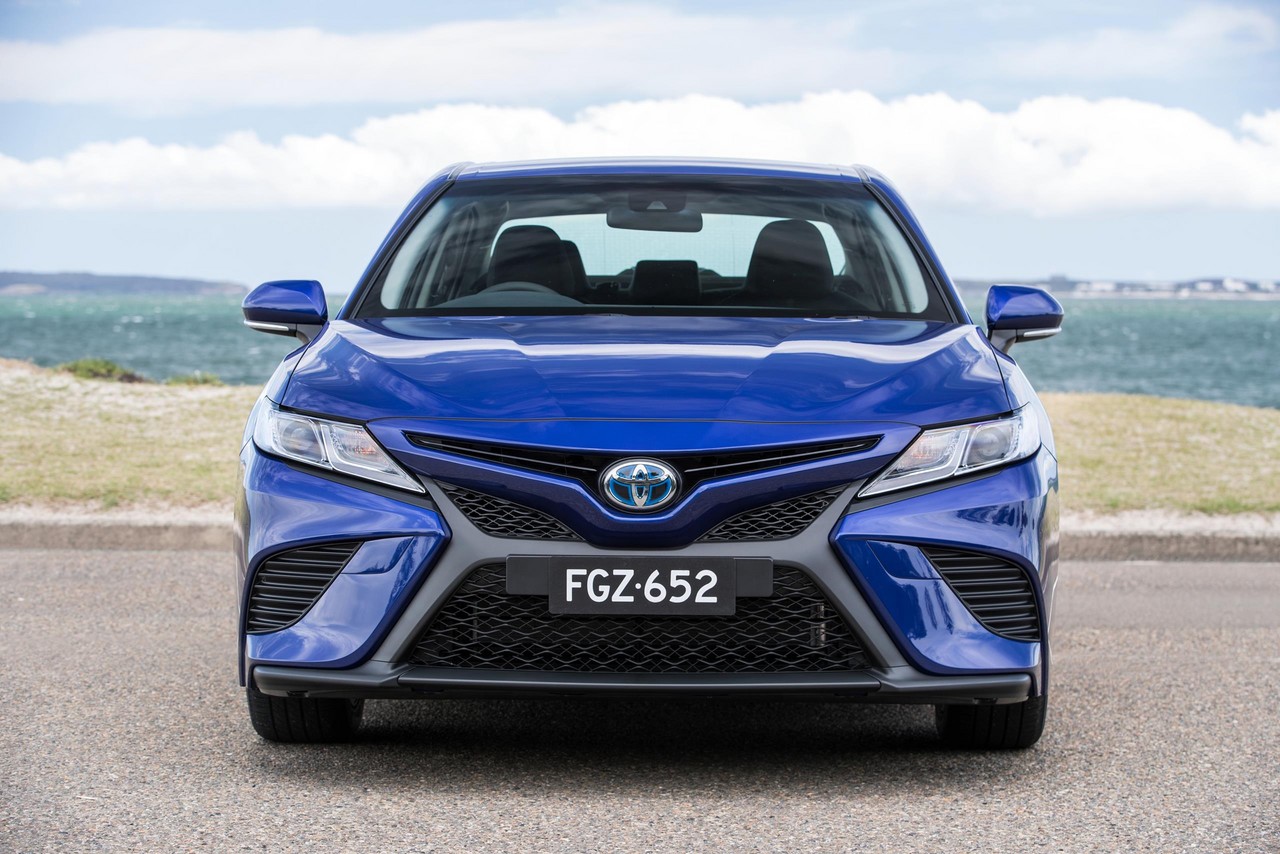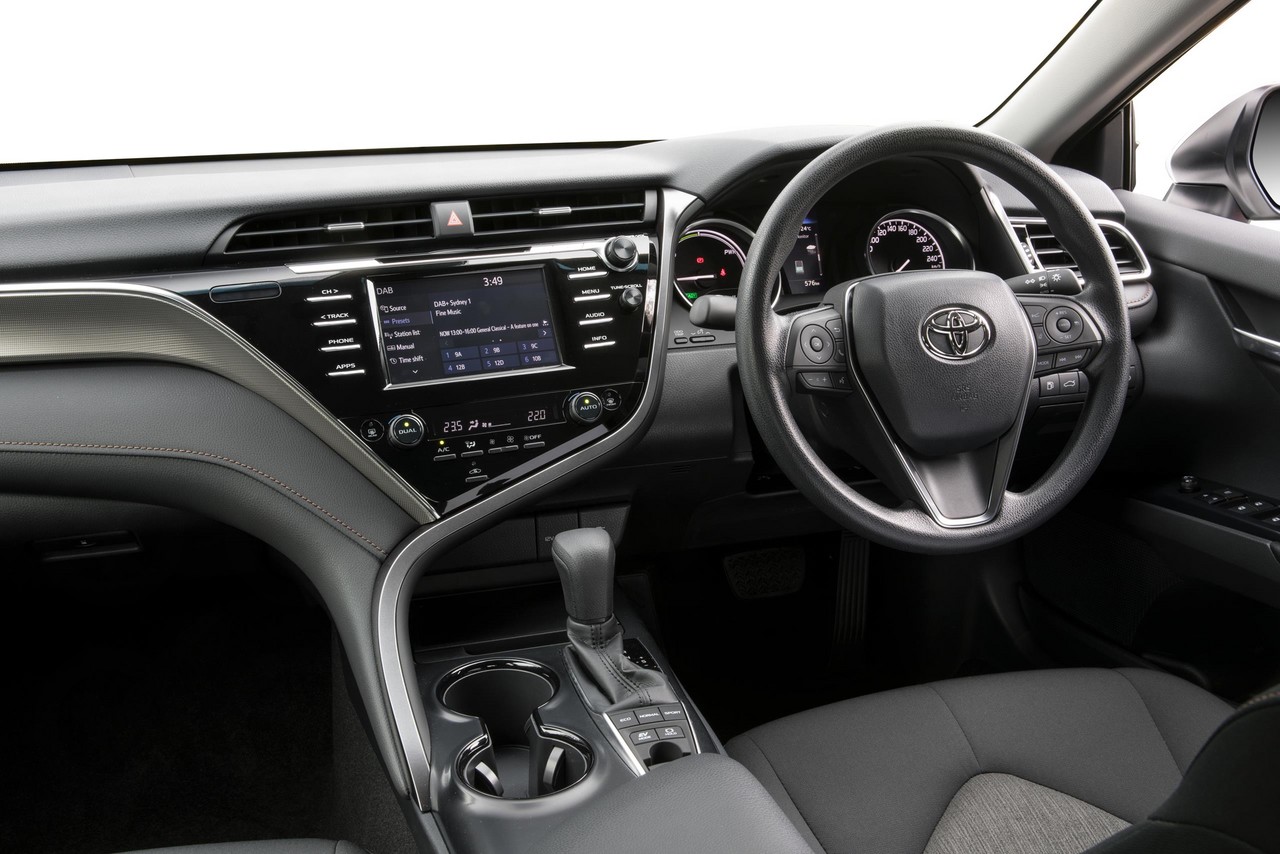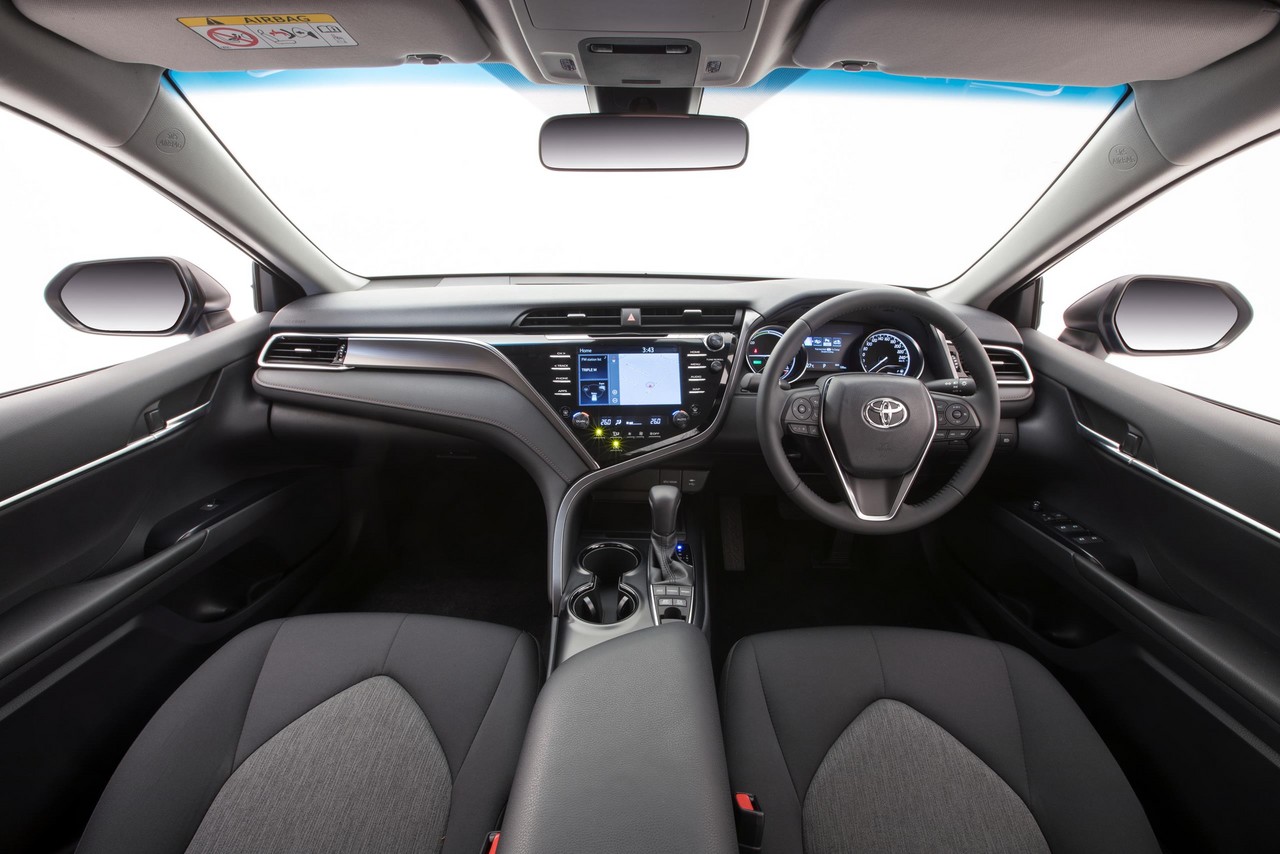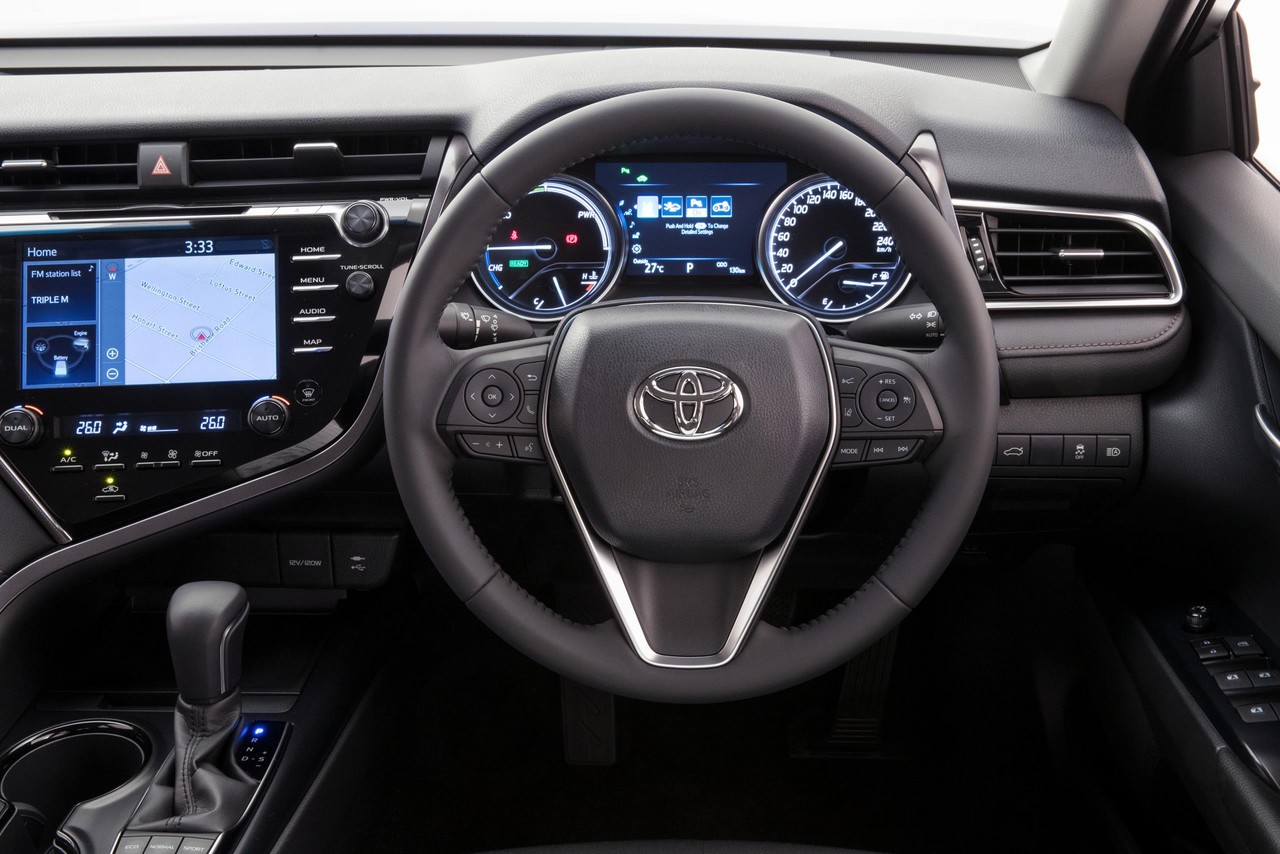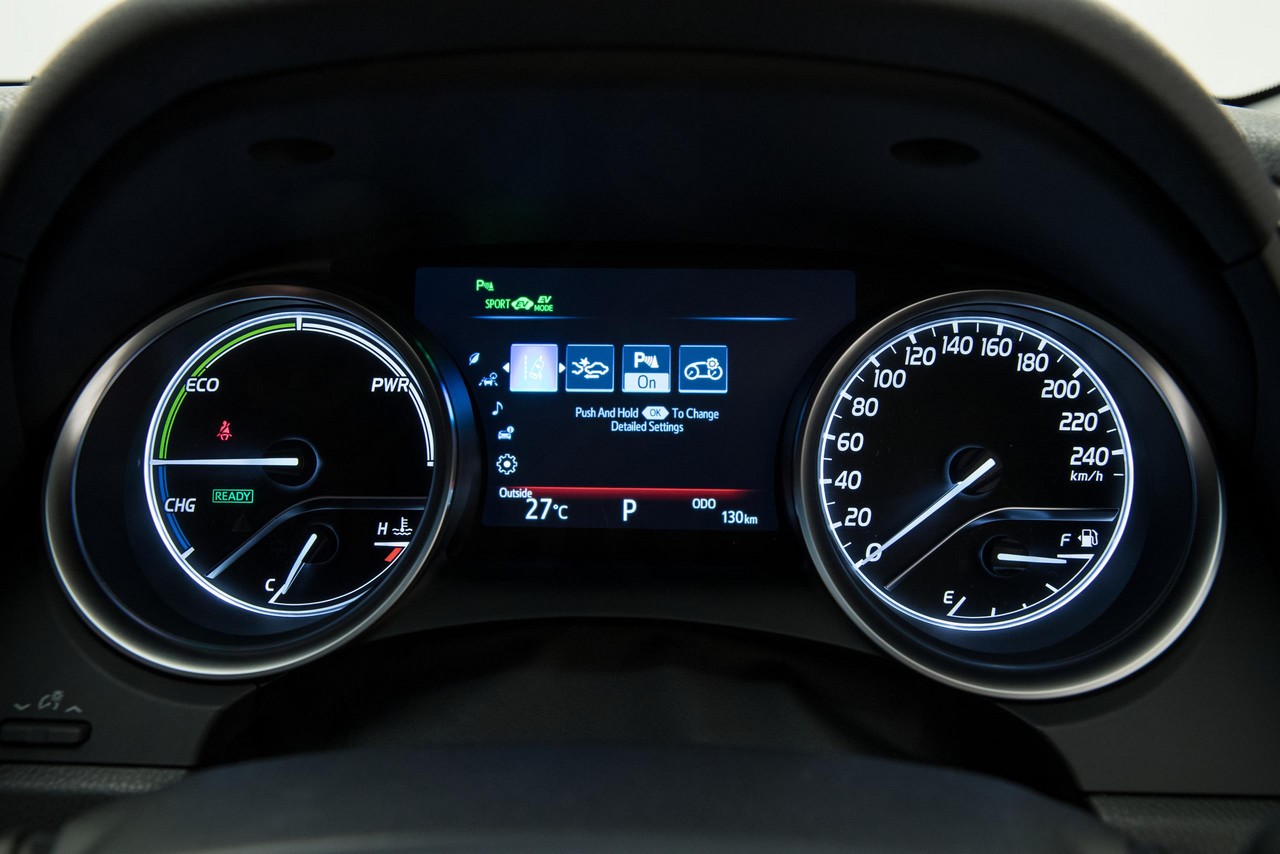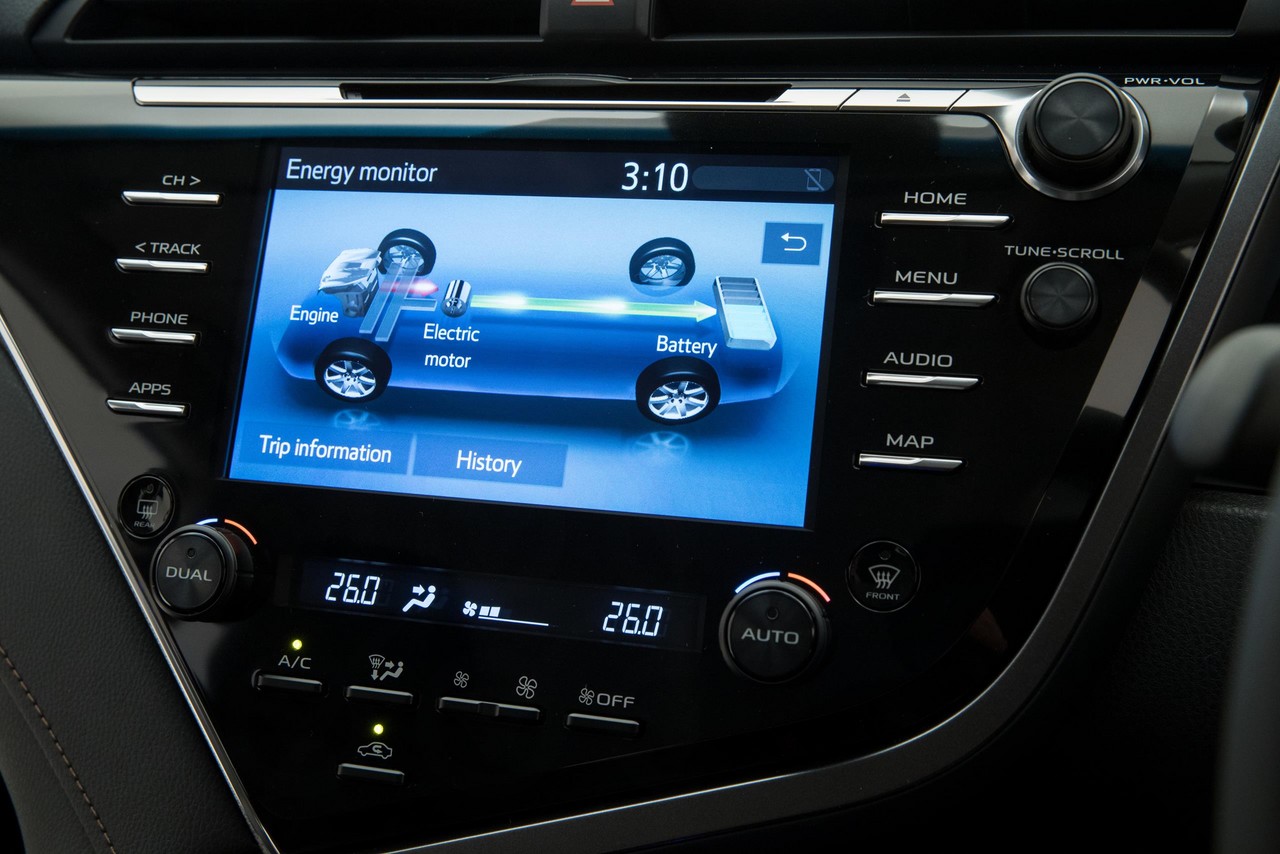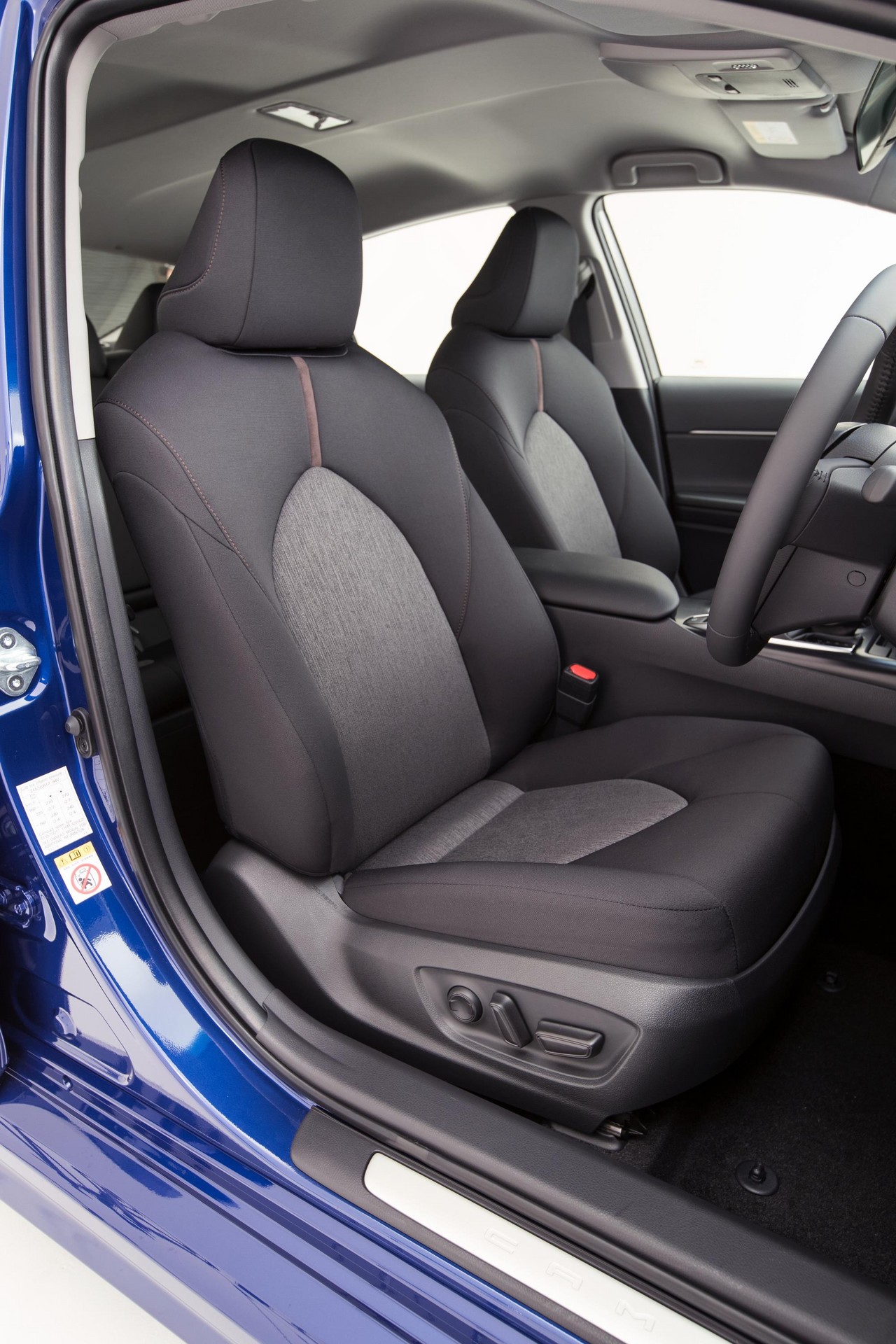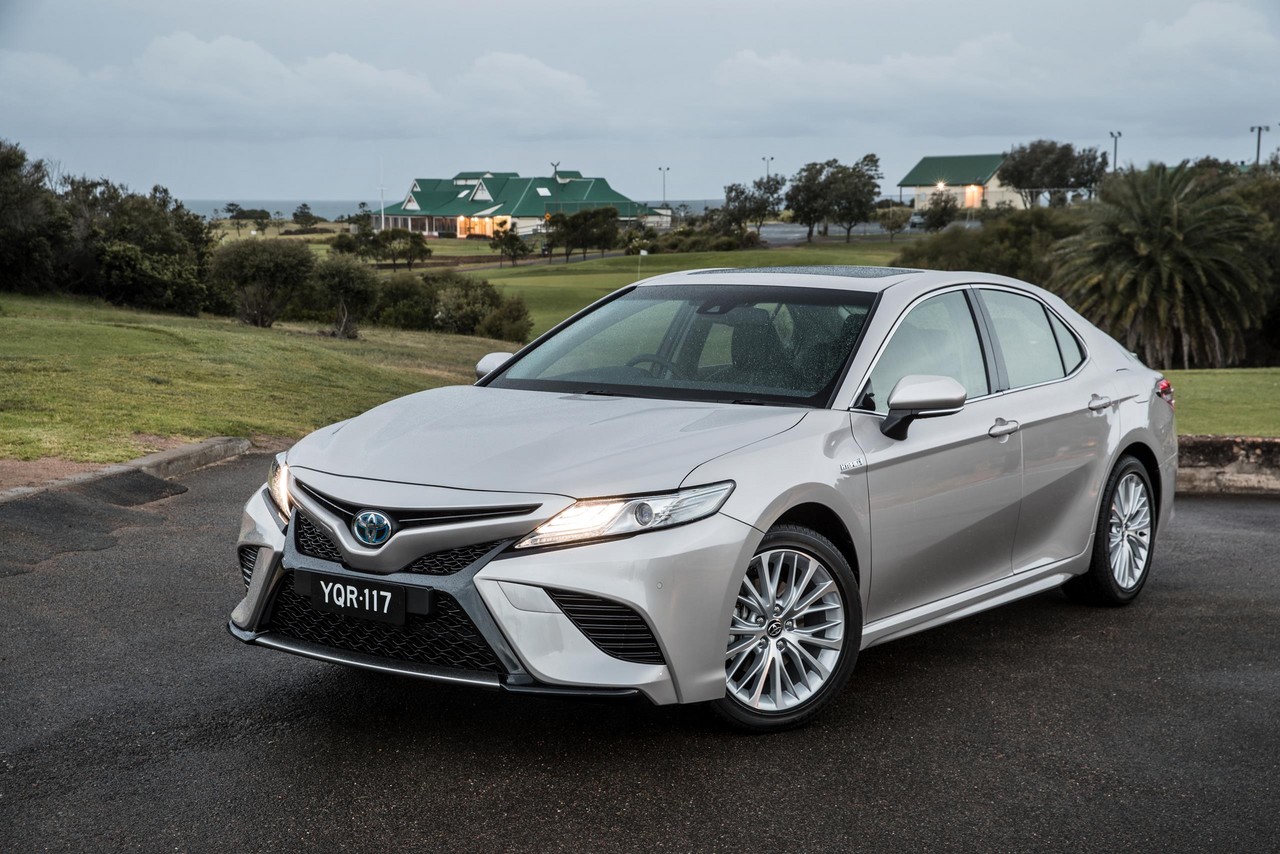
- Efficient hybrid powertrain
- Accomplished ride/handling balance (double wishbone rear suspension makes this the best handling Camry ever)
- Steering is accurate…
- … but lacks feel
- Blind Spot Monitor and Rear Cross Traffic Alert should be standard
- Lane Departure system struggles to detect lane markings and initiate counter-steering
- Apple CarPlay and Android Auto not available
- Sunroof reduces headroom (standard for Camry Hybrid SL)
- Glare from high-gloss black plastic
Overview
Released in Australia in November 2017, the Toyota XV70 Camry Hybrid was a mid-size sedan. Manufactured in Aichi, Japan, the Toyota XV70 Camry Hybrid was powered by a 2.5-litre petrol engine and an electric motor which drove the front wheels via a continuously variable transmission (CVT). Furthermore, the XV70 Camry Hybrid range consisted of Ascent, Ascent Sport and SL variants.
Toyota XV70 Camry Hybrid: A25A-FKS engine and electric motors
The four-cylinder XV70 Camry was powered by Toyota’s A25A-FKS engine. Within its die-cast aluminium alloy cylinder block, the A25A-FKS engine had 87.5 mm bores and a 103.4 mm stroke for a capacity of 2487 cc. Other attributes of the A25A-FKS engine included its aluminium alloy cylinder head, double overhead camshafts (chain-driven), roller rocker arms, four valves per cylinder and compression ratio of 14.0:1. Key features of the A25A-FKS engine included:
- Toyota’s ‘D-4S’ fuel injection system which combined direct injection (via six-hole nozzle injectors) with traditional port injection for more precise air/fuel mixing under low and medium load conditions;
- A 41 degree angle (approximately) between the intake and exhaust valves;
- For the intake valves, VVT-iE camshaft timing which used an electric motor to vary the VVT-i controller for camshaft advance or retard. In contrast, the exhaust camshaft had a conventional hydraulic VVT-i system in which the camshaft timing oil control valve controlled a spool valve that enabled hydraulic pressure to be applied to the advance or retard side of the VVT-i controller. In response, rotation of the VVT-i controller vane sub-assembly (relative to the timing chain sprocket) varied valve timing. The exhaust camshaft also had a mid-position lock mechanism; and,
- In a world first, a trochoid-type continuous variable capacity oil pump.
The A25A-FKS engine is understood to have two counter-rotating balance shafts. According to Toyota, the A25A-FKS engine had a thermal efficiency of 40 per cent for its petrol-powered vehicles and 41 per cent in hybrid vehicles.
For the Toyota XV70 Camry Hybrid, the A25A-FKS engine was combined with two electric motor generators (MG1 and MG2), though only MG2 was used to power the front wheels. Compared to the Toyota XV50 Camry Hybrid , changes for the XV70 Camry Hybrid included:
- A more compact transaxle due to a multi-shaft layout where MG1 and MG2 are each located on a different axis (rather than sharing a single axis). By using a parallel axis gear, instead of the previous planetary gear, losses from the gear train are reduced;
- The redesigned nickel-metal hydride (Ni-MH) battery had newly developed ‘Hyper-Prime Nickel’ technology to improve performance while reducing size and weight. The battery had a nominal voltage of 244.8 V (204 cells, 1.2V/cells), a capacity of 6.5 ampere hours and a system voltage of 650 volts;
- Improvements in the conversion efficiency of the power control unit (PCU) and the transaxle/electric motor which reduce energy losses by about 20 per cent. Furthermore, Toyota claims that improvements to the cooling system efficiency reduce energy losses by about 10 per cent;
- A lighter and more compact PCU due to the integration of micro-controllers and adoption of a new power stack structure which enables it to be positioned above the transaxle; and,
- A revised DC-DC converter with optimised output control – including the conversion to AC power – that reduces overall power consumption.
For the XV70 Camry Hybrid, the driver could select from four drive modes: EV, Normal, Eco and Sport. When using Eco mode, the Auto Glide Control (AGC) function improved fuel efficiency by calculating an efficient coasting logic. Specifically, the system limited the loss of vehicle speed to provide smooth engine braking and allow the vehicle to coast to rest.
| Engine | Trans. | Peak power | Peak torque |
|---|---|---|---|
| 2487 cc A25A-FKS petrol I4 | CVT | 131 kW at 5700 rpm | 221 Nm at 3600-5200 rpm |
| 650 volt electric motor | 88 kW at 4500 rpm | 202 Nm at 0-1500 rpm | |
| Combined | 160 kW | N/A | |
Dimensions and body
The Toyota XV70 Camry Hybrid was underpinned by the ‘Toyota New Generation Architecture’ (TNGA) which is shared with the Toyota C-HR and Toyota XW50 Prius . Called the GA-K platform for the Toyota Camry, this platform provided a lower centre of gravity, hip point, shoulder line, roof line and bonnet height. Compared to the Toyota XV50 Camry Hybrid , the Toyota XV70 Camry Hybrid was 90 mm longer (at 4905 mm), 15 mm wider (1840 mm), 25 mm lower (1445 mm) and had a 50 mm longer wheelbase (2825 mm). Furthermore, luggage space is improved by 30 litres due to the battery being relocated from the boot to beneath the rear seat.
Significantly, the body of the Toyota XV70 Camry Hybrid achieved a 30 per cent increase in torsional rigidity relative to its XV50 predecessor – this was achieved through:
- The increased use of ultra-high-tensile steel and hot stamping materials (which also reduce mass);
- At key junctures, laser screw welding with a greater number of weld points;
- A special urethane adhesive where the windscreen and rear window meet the body;
- Additional gussets for the centre pillars;
- Closed cross-section construction for the front suspension tower brace;
- A new rear body frame of annular construction; and,
- Additional braces for the rear suspension which improve lateral rigidity.
To reduce mass, the XV70 Camry Hybrid had thinner body panels for the roof, bonnet, boot lid, doors and front fenders. Kerb weights for the Toyota XV70 Camry Hybrid ranged from 1580 kg to 1635 kg.
To reduce interior noise, the XV70 Camry Hybrid had:
- A thicker dash silencer mat across the entire interior firewall;
- A special vibration-damping coating that was applied over a wider area of the underfloor;
- Greater coverage of noise-proofing material for the interior’s ceiling; and,
- To reduce wind noise, a newly-designed rain gutter moulding and a reduction in the step at the bottom of the windshield.
Suspension
The Toyota XV70 Camry Hybrid had MacPherson strut front suspension and double wishbone rear suspension. The rear suspension had separate spring and damper units, with the dampers inclined forward to reduce longitudinal low-frequency inputs. Furthermore, the dampers were positioned forward of the axle line and the coil springs behind to maximise luggage space. To reduce high-frequency road inputs, all arm joints had bushings and the trailing-arm bushings were specifically tuned to reduce road shock.
Steering
The Toyota XV70 Camry Hybrid had rack-and-pinion steering with speed-sensitive, electric power assistance. To reduce the XV70 Camry Hybrid’s centre of gravity, the electric motor was mounted on the rack housing.
For the Camry Hybrid Ascent and Ascent Sport, the steering gear ratio was 13.7:1 and the steering wheel required 2.71 turns from lock-to-lock. For the Camry Hybrid SX and SL, however, the steering ratio was 13.8:1 and the steering wheel required 2.64 turns from lock to lock.
Safety equipment
Standard safety equipment for the Toyota XV70 Camry Hybrid included dual front airbags, a driver’s knee airbag, front seat-mounted side airbags, full-length curtain airbags (i.e. for front and rear occupants), ABS, electronic brake force distribution, brake assist, electronic stability control, traction control and front seatbelts with pre-tensioners and load limiters.
As standard, the Toyota Camry Hybrid was equipped with the following active safety technologies –
- Pre-Collision System (PCS) with Autonomous Emergency Braking (AEB): operated at speeds above 10 km/h and used a windscreen-mounted camera and millimetre-wave radar sensor to detect vehicles on the road ahead. If a collision risk was detected, a buzzer would sound and an alert would be displayed in the multi-information display. Furthermore, Pre-Collision Brake Assist would prepare the braking system to provide additional braking force when the brake pedal was applied. If the driver did not react and the probability of a frontal collision with a vehicle was extremely high, autonomous emergency braking (AEB) would be initiated to reduce vehicle speed;
- Active Cruise Control (ACC): used the same millimetre-wave radar as the pre-collision system to maintain a set distance from the vehicle ahead. If necessary, the system could slow the car until stationary and accelerate back to the pre-selected cruising speed when the road ahead had cleared;
- Lane Departure Alert (LDA): used the camera on the windscreen to monitor the vehicle’s position within lane markings on the road surface. If the Camry Hybrid was about to depart from its lane without the turn indicators having been applied, a buzzer would sound and a warning would be displayed in the multi-information display. If the vehicle continued moving outside its lane, light steering force would be applied to assist the driver to bring the vehicle back on course. LDA included a Sway Warning System that monitored driving behaviour for signs of fatigue. If detected, a buzzer would sound and a message in the multi-information display would recommend that the driver take a break from driving; and,
- Automatic High Beam (AHB): used the windscreen-mounted camera to detect the lights of coming vehicles or traffic ahead. If detected, the vehicle would switch the headlights to low beam to avoid dazzling other road users. Once the road was clear, the headlights would revert to high beam for maximum illumination.
The Toyota Camry Hybrid SL was further equipped with –
- Blind-Spot Monitor (BSM): used radar sensors on the rear corners of the vehicle to detect nearby vehicles in adjacent lanes as they moved into the driver’s blind spot. If detected, the driver would be alerted by illumination of LED indicators in the door mirror on that side of the vehicle. The LED indicators would remain illuminated for as long as the vehicle remained in the blind spot. If the driver operated the turn indicators with the intention of moving into the path of the other vehicle, the LEDs would flash rapidly; and,
- Rear Cross-Traffic Alert (RCTA): used the rear radar sensors to detect approaching traffic when the vehicle was reversing out of a parking space. If detected, the driver would be alerted.
ANCAP safety rating
In ANCAP testing , the Toyota XV70 Camry received a five star adult occupant protection rating with a score of 36.16 out of 37. In the frontal offset test, protection of the driver’s head, thighs and feet were rated as good, though chest and lower leg protection was rated as adequate (i.e. a slight risk of serious injury). Maximum points, however, were awarded in the side impact and pole tests.
Brakes
The Toyota XV70 Camry Hybrid had 305 mm by 28 mm ventilated front brake discs and 281 mm by 10 mm solid rear discs.
Features: Toyota XV70 Camry Hybrid Ascent
Standard features for the Toyota XV70 Camry Hybrid Ascent included 17-inch x 7.5J alloy wheels with 215/55 R17 tyres, a six speaker sound system, 3.5 mm auxiliary and USB inputs, a seven-inch colour touchscreen, Bluetooth mobile phone connectivity and audio streaming, ‘Toyota Link’ connected mobility system for smartphone integration, a driver’s seat with power lumbar adjustment, dual-zone climate control air conditioning, bi-LED headlamps, LED daytime running lamps, a reversing camera, 60/40 split-fold rear seats, remote central locking, proximity key (i.e. keyless entry) and push-button start, power mirrors and windows, a tilt and telescopic steering wheel adjustment, a 12 volt accessory outlet, an electric park brake, a 4.2-inch Multi Information Display (MID), ‘Optitron’ instrument illumination, a trip computer, an alarm and immobiliser.
As standard, the Camry Hybrid was fitted with a space-saver spare wheel.
Features: Toyota XV70 Camry Hybrid Ascent Sport
Compared to the Camry Hybrid Ascent, the Camry Hybrid Ascent Sport added satellite navigation with an eight inch colour touchscreen and SUNA live traffic updates, a power adjustable driver’s seat (slide, recline and vertical adjustment), dual-zone climate control air conditioning, front and rear parking sensors, ‘premium’ steering wheel and gear lever, stainless steel scuff plates, proximity key (i.e. keyless entry) and push-button start, and a seven-inch colour Multi Information Display (MID).
Visually, the Camry Hybrid Ascent Sport could be identified by its ‘sports’ front grille with matte finish, side skirts and sports rear bumper. As standard, the Camry Hybrid Ascent Sport was fitted with a temporary spare wheel.
Features: Toyota XV70 Camry Hybrid SL
The range-topping Toyota XV70 Camry Hybrid SL was distinguished by its 18-inch x 8.0J alloy wheels with 235/45 R18 tyres, leather accented seats, ventilated front seats, driver’s seat memory settings, power adjustable front passenger seat, ten-inch colour head-up display (HUD), rain-sensing wipers, steering wheel gearshift paddles, power adjustable steering wheel, electrochromatic rear-view mirror, wireless mobile phone charger, power-operated tilt and slid moonroof, two additional USB charging points (rear) and ‘intelligent’ ambient illumination for the console and footwell. Visually, the Camry Hybrid SL could be identified by its high-gloss front sports grille.
Brochure
Related links
- Toyota Australia: 2017 Toyota Camry Press Kit (November 2017)
- Toyota Australia: 2017 New-Generation Toyota Camry Preview Press Kit (June 2017)
- Toyota USA: Ready for Launch – The Countdown Begins for the 2018 Toyota Camry (June 2017)
- Toyota Australia: Toyota Reveals New Model Camry (January 2017)
- Toyota USA: All-New 2018 Toyota Camry (January 2017)

